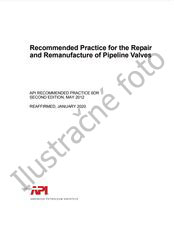Potrebujeme váš súhlas na využitie jednotlivých dát, aby sa vám okrem iného mohli ukazovať informácie týkajúce sa vašich záujmov. Súhlas udelíte kliknutím na tlačidlo „OK“.

API RP 2003-ed.8
Protection Against Ignitions Arising Out of Static, Lightning, and Stray Currents
NORMA vydaná dňa 1.3.2020
Informácie o norme:
Označenie normy: API RP 2003-ed.8
Dátum vydania normy: 1.3.2020
Kód tovaru: NS-1140065
Počet strán: 84
Približná hmotnosť: 283 g (0.62 libier)
Krajina: Americká technická norma
Kategória: Technické normy API
Anotácia textu normy API RP 2003-ed.8 :
API RP 2003, 8th Edition, September 2015 - Protection Against Ignitions Arising Out of Static, Lightning, and Stray Currents
General
This recommended practice (RP) presents the current state of knowledge and technology in the fields of static electricity, lightning, and stray currents applicable to the prevention of hydrocarbon ignition in the petroleum industry and is based on both scientific research and practical experience. Furthermore, the principles discussed in this RP are applicable to other operations where ignitable liquids and gases are handled. Their use should lead to improved safety practices and evaluations of existing installations and procedures. When the narrow limits of static electricity ignition are properly understood, fire investigators should be encouraged to search more diligently for the true ignition sources in instances where static ignition is unlikely or impossible.
Following this recommended practice is not required where:
- a) static discharges may occur, but flammable vapors are verified to be excluded by gas freeing or inerting the atmosphere in the area of discharge;
- b) product handling occurs in a closed system, and oxygen in that system is verified to be below the minimum concentration required to support combustion, such as in the handling of liquefied petroleum gas (LPG);
- c) the flammable concentration is verified to be above the upper flammable limit (UFL).
This document does not address electrostatic hazards relating to solids handling. (See [4], [5], and [15] in the Bibliography.) Vehicle fueling (truck or passenger car) is also outside the scope of this document.
Concept of Hazard vs Risk
Hazards are situations or properties of materials with the inherent ability to cause harm. Flammability, toxicity, corrosivity, stored electrical, chemical, or mechanical energy all are hazards associated with various industrial materials or situations. Charge separation and the accumulation of a static charge are inherent properties of low conductivity hydrocarbon fluids.
Risk includes a consequence such as a hot surface or material that can cause thermal skin burns or a corrosive acid can cause chemical skin burns, but these can occur only if there is contact to the skin. An accumulated static charge can be a source of ignition only if exposed to a flammable fuel-air mixture under conditions where a discharge is possible. There is no risk when all the required elements do not exist; charge accumulation, flammable mixture, and spark discharge.
Determining the level of risk involves estimating the probability and severity of exposure of an event that could lead to harm. While the preceding examples relate hazards to the risk to people, the same principles are valid for evaluating risks to property and the environment. For instance, hydrocarbon vapors in a flammable mixture with air can ignite if exposed to a source of ignition (such as a static discharge) resulting in a fire which could injure people or damage property.
Units of Measurement
Values for measurements used in this document are generally provided in both U.S. customary and SI (metric) units. To avoid implying a level of precision greater than intended, the second cited value may be rounded to a more appropriate number. Where specific code or test criteria are involved, an exact mathematical conversion is used. Some conversions are included in Annex D.
Odporúčame:
Aktualizácia technických noriem
Chcete mať istotu, že používate len platné technické normy?
Ponúkame Vám riešenie, ktoré Vám zaistí mesačný prehľad o aktuálnosti noriem, ktoré používate.
Chcete vedieť viac informácií ? Pozrite sa na túto stránku.



 Cookies
Cookies
